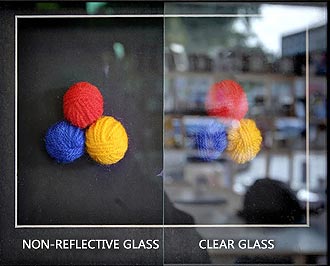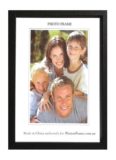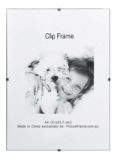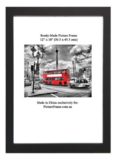This is the most common of glazing (to glaze means to furnish, cover or fill with glass) materials used in both commercial picture frames and custom picture frames. It is called float glass because it is made by floating molten glass on a bed of molten metal, usually tin during the Pilkington process.
Depending on where the silica sand is mined from, it may have  a greenish, yellow or even pink tinge. Picture frames and photo frames glass panes are cut down to size by picture framers from large sheets, commonly 1800 x 1200 cms x 1.8mm thick which framers buy from glass wholesalers. Nearly 100% of this is imported glass and generally it is made to conform to Asahi glass standards.
a greenish, yellow or even pink tinge. Picture frames and photo frames glass panes are cut down to size by picture framers from large sheets, commonly 1800 x 1200 cms x 1.8mm thick which framers buy from glass wholesalers. Nearly 100% of this is imported glass and generally it is made to conform to Asahi glass standards.
There are no picture framing glass manufacturers remaining in Australia because our high manufacturing costs make glass manufacturing uncompetitive. Asahi standards help to ensure that glass is of high clarity, light transmission, manufactured in uniform good quality and free of seeds, cords and other defects.
This type of glass is the cheapest of all picture framing glazing materials and this is another reason why it is the most used and most popular. It has excellent clarity and blocks about 55% of harmful Ultra Violet (UV) light absorption. This means that round about half of the diffused, harmful UV, are capable of penetrating and damaging artwork.
This matters little when the framed art is inexpensive, common, cheap, disposable reproductions and commercial art of little value to the customer. However if the picture frame, or photo frame for that matter, contains rare, valuable or significant art then this type of glass should not be used because UV rays will visibly damage and bleach the art in as relatively as short a time span of five to seven years.
Clear float glass is also highly reflective, a quality not always appreciated by Customers and remedied by only by having artwork glazed with non-reflective glass.
With regular, reflective, clear, float glass, the available natural or artificial light, illuminates the artwork, penetrates the glass and then filters back into your eyes. The brain then decodes this visual information in recognizable and familiar shapes, colour tones, tints and shades. Unfortunately, and at most angles, the light is also reflected by the glass, much like a mirrors do.
When this happens,  dazzling halos, or bright spots, of intense light are created. These are the reflections that can spoil, distract and detract from our viewing pleasure. This problem was recognized long ago and the invention that remedied it, to a great extent, albeit not, completely, is called Non-Reflective Glass, or Non-Glare Glass, or Diffused Glass, or Matte Glass, take your pick although the first name is the one used most here in Australia.
dazzling halos, or bright spots, of intense light are created. These are the reflections that can spoil, distract and detract from our viewing pleasure. This problem was recognized long ago and the invention that remedied it, to a great extent, albeit not, completely, is called Non-Reflective Glass, or Non-Glare Glass, or Diffused Glass, or Matte Glass, take your pick although the first name is the one used most here in Australia.
This glass has one, or both surfaces, slightly etched by immersion in an acid bath. This is the most common manufacturing method, because it’s the cheapest. The acid immersion renders the glass surfaces a little rough, as though sanded, so that when the light hits it, it scatters in all directions. This light rays scattergun effect virtually eliminates the glare form halos and bright spots, thus making viewing easier, less distracting and more pleasurable.
There at least three distinct drawbacks to having your pictures framed with non-reflective glass. The first is cost. Picture framers will price non-reflective glass at least 2 to 3 times the price of clear glass because that’s what it costs them to buy it. The second is clarity. Non-reflective glass has a refraction loss of up to 13%. In other words, your art will look 13% duller, or more opaque, than when using clear glass.
Thirdly, and because of the refraction loss, it can only be used when pressed directly against the art. It cannot be used for 3-dimensional artwork because, when raised for the surface of the art, it will completely dull it making it too opaque to be viewed. Lastly, and contrary to popular belief, non-reflective glass does not block out all UV rays. It filters out only about half, or, pretty much the same as clear glass.
Even weak daylight rays will slowly but surely fade the inks in a photograph or print by “bleaching” the colours. All light contains ultraviolet or “UV” rays and most picture frames are glazed with ordinary, clear picture framing glass.
This type of glass blocks only about half of the UV rays and will not conserve colours or prevent fading. However, to retard  fading, as absolute prevention is almost impossible, picture framers can use “UV” filtering glass. While this special type of glass is dearer, it has been proven to block over 97% of the harmful “UV” rays. UV glass is certainly worth considering when picture framing any item which is irreplaceable or of any commercial, sentimental, historical or, emotional or personal value.
fading, as absolute prevention is almost impossible, picture framers can use “UV” filtering glass. While this special type of glass is dearer, it has been proven to block over 97% of the harmful “UV” rays. UV glass is certainly worth considering when picture framing any item which is irreplaceable or of any commercial, sentimental, historical or, emotional or personal value.
Most Australian picture framers generally stock picture framing glass in three varieties. Clear float glass, non-reflective (etched on one side or both sides to reduce reflection) and “UV” filtering clear and museum quality. Specialist picture framers, conservators and museums have access to yet more types of special museum glass for specialised picture frames or museum picture framing.
Precious, valuable and irreplaceable artwork if at all framed, should be glazed with UV-blocking glass to combat fading. UV rays are present in al light, sunlight, artificial incandescent and artificial fluorescent. Sunlight presents the most (so far as artwork is concerned) danger. Artificial, indoor lighting such as fluorescent also carries some, but tungsten, not as much. UV rays break the inner bonds of emulsions, pigments and colours.
The image becomes faded and looks washed out. This phenomenon is known as photolysis. Another danger to UV exposure is photo-oxidation. The same colour particulate molecules mentioned before become sensitive to oxidation as a combination of mixing with oxidizing agents such as ozone. The long term result contributes to the “yellowing” or paper.
Scientific research indicates that the main source of light in a home is sunlight coming though the window panes. But because we want to “see” our framed pictures, we don’t keep them locked away in a dark drawer though this is probably a good way of prevent fading. Strangely enough, if we keep photos stored in shoe boxes or in photo album sleeves, these may suffer from the deterioration known as “dark fading”. This is the cumulative damage by pollutants, agents, chemicals and trace elements that do not need ambient light.
Rather, dark fading is cause by concomitant factors such heat, humidity, gases, particulates and pollution.Typically photos are stored in albums, inside houses and at room temperature of about 20c. But this high temperature shortens the life duration of the photos which should really be store at much cooler, and controlled temperatures. Then again, we don’t really like to store our photos inside the refrigerator. Concluding, if we are to display valuable, prized and cherished art on our walls, we ought to make sure that these are glazed with UV-blocking glass.
In picture framing plastic glazing can offer several advantages over glass glazing and the most common acrylic glazing material that is used is cast plastic, rather than the extruded or ‘continuous’ type. The reason for this is that the former is of higher quality has less impurities and harder and thus a little harder to scratch. 
Nowadays Chinese-made cast plastic is most often the one now sold in Australia though for many years Plexiglass and Lucite were the dominant brands . Plastic is (depending on the its sheet thickness) much lighter, only about half as heavy as glass, it’s virtually unbreakable or shatter-proof and generally, it offers better U.V. (ultra-violet) protection.
It also insulates better than glass, possibly delaying unwanted condensation during extreme in ambient humidity and temperature. In addition to these superior properties, cast plastic can have a transparency superior the glass and without the colour adulteration. Clear float glass colour adulteration is caused by the sand silica used.
The glass may have a discernible yellow, greenish or pinkish tinge, which can be aesthetically undesirable, particularly with highly prized or valued artwork. Lastly, if a frame isn’t joined or assemble perfectly level and even gaps will show between the rabbet and the glass after fitting up or assembly. But plastic flexes, and this defect would not be as evident using a plastic pane. But plastic glazing can have some disadvantages.
It is 4 to 5 times more expensive than clear float picture framing glass, it scratches easier and is soiled by petrochemicals like oil can’t be cleaned with some common solvents suck as turpentine or petrol. Importantly, it cannot be scored with a hand tool whereas a picture framer can quickly and easily score and snap glass sheets with an inexpensive hand tool, a glass cutter. The sheets of plastics are usually quite large (about 8′ x 4′ or larger) and can only be sawn at high speed, with a carbide-tipped blade using a wall radial panel saw which can cost several thousand dollars.
Picture framers normally do not have the room to store these huge sheets and usually don’t have a radial saw to saw plastics. They will instead phone an order through to a plastic fabricator supplier to have a plastic panel cut to size. Not only is the plastic about 4 time dearer than glass but the plastic sheet supplier or fabricator will usually charge a cutting charge just to cut the one sheet. One fabricator we know of charges $35 just to cut one panel, on top of the cost of the plastic. And because it’s more expensive to glaze picture frames with plastics, it is therefore less popular with customers.
Our photo frames, picture frames, frameless clip frames, football display cases, basketball display cases, and other product ranges can be found online by making Google , or Bing searches. For custom picture frames and custom picture framing price quotations, please use our free, easy and fast Prices Estimator.









